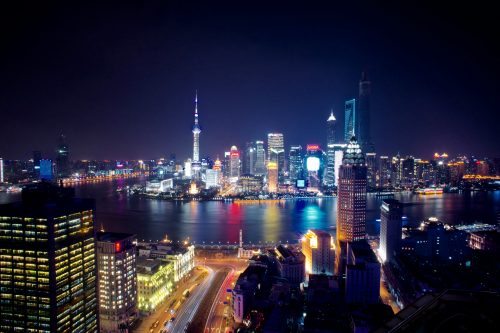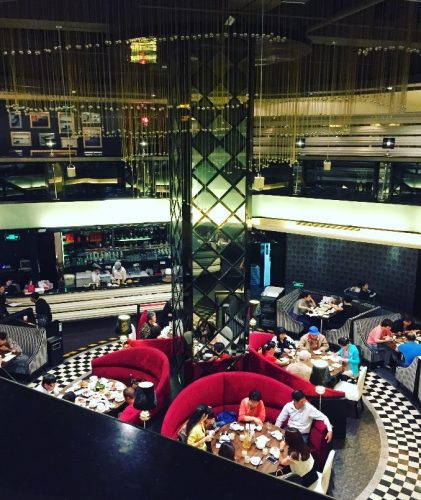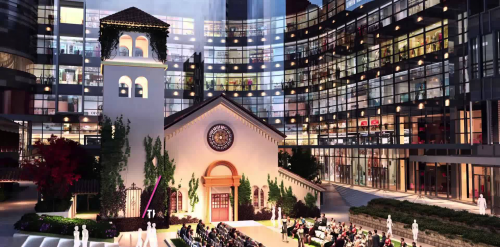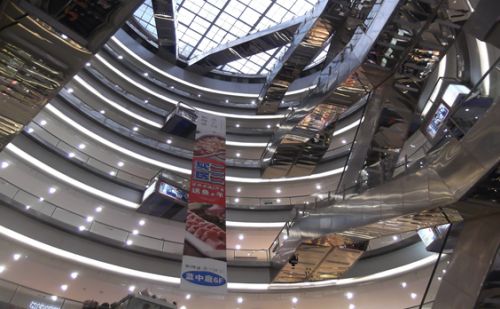
Shanghai’s Pudong Skyline. The city will be the 2018 international real estate case trek destination for students of the Baker Program. Photo Credit: Commons
Shanghai is often observed as a benchmark for China’s consumer and retail trends. In 2017, Shanghai’s population exceeded 25 million people, a staggering record even for the largest city in the world’s most populous nation. Compare this to a population of 4.3 million in 1950 and the city’s explosive growth presents an impressive market for retailers. Shanghai is experiencing renewed growth in retail after a period of relative stagnation. Total retail sales of consumer goods from January to May in 2017 was RMB 468.236 billion (USD 70.732 billion), an annual growth of 8.2%. Retailers have been in close pursuit.
Shanghai has the longest metro system currently at 588 km (365 miles) compared to NYC’s 373 km (231 miles) with plans to expand to 1000 km by 2025. It also has the world’s most extensive bus network. The expansion of public transportation is encouraging the middle class to move out further and further in a familiar pattern of urban sprawl. Massive multi-story shopping centers continue to remain popular with Chinese consumers. Many of these malls are growing rapidly in decentralized locations outside Shanghai’s inner ring. In Q2 of 2017 alone, Shanghai opened 450,000 square meters (4.84 million square feet) of new retail space in the form of six multi-story malls. In addition, the average gross floor area (GFA) of decentralized malls have also grown from 90,000 square meters (968,751 square feet) in 2013-2016 to 120,000 square meters (1.29 million square feet) for malls under construction between 2017-2020. Catchment areas for retail centers of this scale are beginning to overlap with other malls nearby with similar themes. As of 2017, 48% of Shanghai’s shopping centers are now in decentralized regions. At the same time, similar expansions are also occurring within the inner ring.
It appears that many retail developers in Shanghai and cities across China are dangerously close to repeating the same oversights made in the US 30-40 years ago. The average vacancy rates in Shanghai malls have hovered around 12% and have shown a slight decrease in 2017. Nevertheless, these rates do not provide the cautionary signals of overheating in the retail space. While vacancies have declined, retail lease rates have not significantly increased in non-prime shopping districts. Take for example Zhangjiang (张建镇) an area within the more suburban Pudong District (浦东区) of Shanghai. The “town” boasts a vacancy rate only 4.3% lower than prime retail locations, however rental rates are usually discounted by 60-70% compared to prime leases.
A second indicator of Shanghai’s retail space overcapacity is the increase in F&B occupancy. In line with consumer trends, higher experiential demand from consumers has increased F&B tenants in Shanghai shopping centers. Landlords are leasing to F&B tenants up to 30-40% of occupied space. In Q2 of 2017, F&B accounted for 72% of newly leased retail space in the city. The move appears successful in driving foot traffic, however, F&B tenants generally pay lower rents while occupying more space than fashion, jewelry, and cosmetics retailers.
One of many restaurants in Cloud Nine Mall. Photo Credit: Jimin Won
With increased supply, the race for a competitive edge has also become stronger especially within Shanghai’s central areas. Developers are incorporating more unique features into the retail space to distinguish their projects from neighboring shopping centers, sometimes literally next door. For example, this year, CapitaLand REIT opened Raffles City 2 Changning (来福士广场 – 长宁), an extension of its landmark retail center in Singapore. It is the first time a Raffles City opened a second location within the same city. The 93,000 sqm (1 million sqft) multistory-mall is part of a large development complex of 360,000 sqm (3.88 million sqft) alongside a residential and commercial tower. Retailers will range from luxury fashion to even fast food such as White Castle. The project was built on the former site of St. Mary’s School, the alma mater of Elaine Chang, a famous Chinese writer. CapitaLand restored five parcels of the historic area and has dubbed it the “heritage block.” The old European style buildings now house high-end retailers and fine dining venues as an added draw for foot traffic. At the same time, Cloud Nine shopping center (龙之梦购物中心) sits right across the street. The eight-story megamall is one of Shanghai’s largest, with over 185,000 sqm (2 million sqft) GLA completed in 2006. Cloud Nine has suffered over the years with declining foot traffic and the effect Raffles City may have on its future will provide an interesting case study on how large retail centers compete in extremely dense global cities.
Raffles City Changning Photo Credit: CapitaLand
Atrium of Cloud Nine Mall. Photo Credit: Commons
The growing percentage of Shanghai’s malls in decentralized locations, falling rents in many non-prime shopping centers, and the increasing size of retail destinations throughout the city are troubling signs of overbuilding and oversupply. The retail landscape in Shanghai seems to be a relentless competition of new taking over near-new. New World Department Store (新世界) a large retailer one block away from Raffles City 2 and Cloud Nine Mall, recently announced its closure after 13 years in operation and may be a harbinger of many casualties to come from overdevelopment in Shanghai’s retail space. It appears that Shanghai’s retail space has already entered the early stages of overheating.



